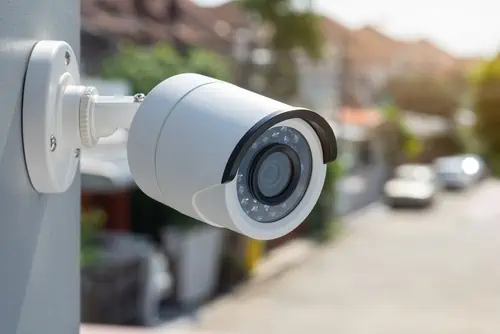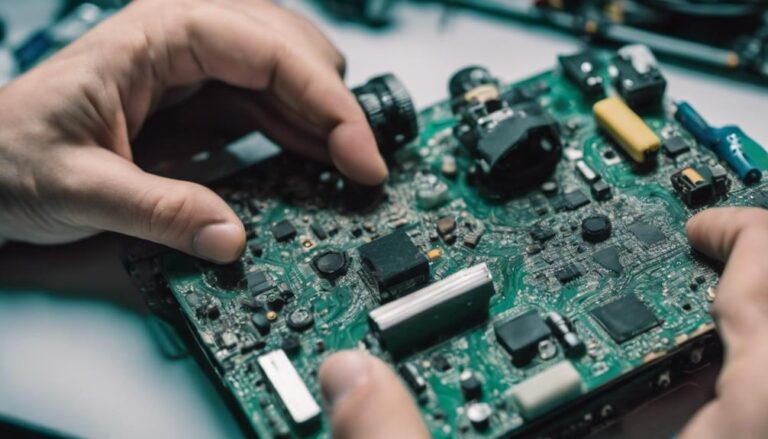For ideal outdoor surveillance, bullet cameras are often the best choice. They’re perfect for long-range viewing, making them perfect for monitoring driveways, parking lots, and backyards. These cameras feature powerful lenses for capturing detailed images from a distance and come with mounting brackets for easy directional adjustments. Additionally, their cylindrical shape offers a deterrent effect. While other options like dome and PTZ cameras have their advantages, bullet cameras provide a balance of cost-effectiveness, ease of installation, and high performance. Want to explore more about the versatility of other types of outdoor CCTV cameras? Keep going.
Bullet Cameras
When evaluating outdoor CCTV cameras, bullet cameras stand out due to their cylindrical shape, which allows for long-range viewing and easy directional adjustments. This design makes them ideal for monitoring expansive outdoor areas such as driveways, parking lots, and backyards. Their extended shape isn’t just for show—it houses powerful lenses that can capture detailed images from a distance, making them perfect for situations where you need to keep an eye on a large perimeter.
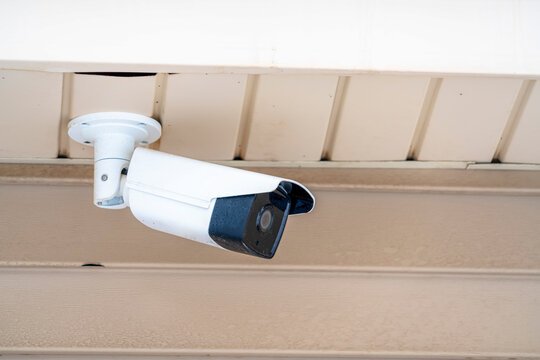
Choosing the right camera placement is important for maximizing the effectiveness of bullet cameras. Since they offer a long-range view, you’ll want to position them at strategic points where they can cover the most ground. For instance, mounting them at the corners of your property can provide a thorough view of the entire area.
Additionally, bullet cameras typically come with a mounting bracket that allows for easy adjustments in both horizontal and vertical directions, giving you the freedom to reposition them as needed to adapt to changing security requirements.
Installation height is another key factor to take into account. Mounting your bullet cameras at a higher elevation, around 8 to 10 feet, can help prevent tampering and vandalism. This height also provides a wider field of view, allowing the camera to capture more area. However, you don’t want to go too high, as it may result in loss of detail in the captured images. Finding the right balance in installation height ensures that you maximize both the coverage and the quality of the footage, giving you the freedom to monitor your property effectively.
Dome Cameras
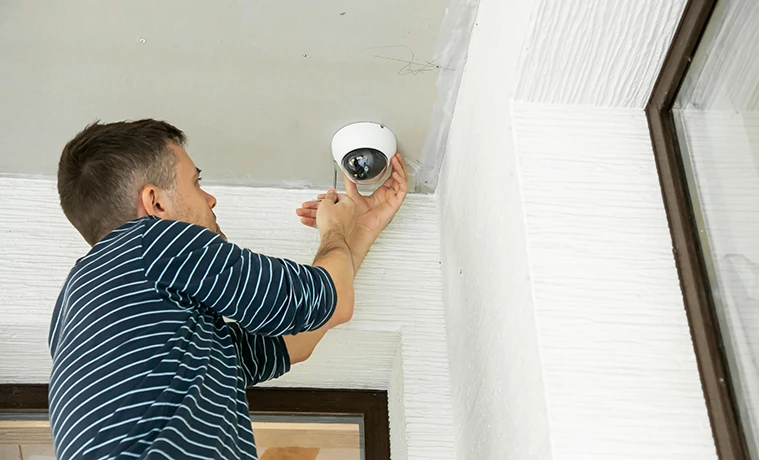
When considering dome cameras, you’ll want to focus on their weather resistance features, which guarantee longevity in harsh outdoor conditions.
Additionally, their vandal-proof design makes them a robust choice for high-risk areas.
Night vision capability is another essential aspect, providing clear footage even in low-light environments.
Weather Resistance Features
Dome cameras provide important weather resistance features, including IP ratings that guarantee they can withstand harsh environmental conditions, making them ideal for outdoor surveillance. These cameras often come with IP66 or IP67 ratings, ensuring they’re dust-tight and protected against powerful water jets or temporary submersion.
For those seeking freedom from frequent maintenance, dome cameras offer corrosion protection, a vital feature if you’re installing them in coastal or industrial areas where salt and chemicals can cause rapid degradation.
Moreover, UV resistance is an essential factor to keep in mind. Dome cameras with UV-resistant housings prevent material degradation and color fading when exposed to direct sunlight over prolonged periods. This means that your camera will maintain its structural integrity and aesthetic appeal, even under intense sunlight.
When comparing dome cameras to other types, such as bullet or turret cameras, you’ll find that dome cameras are especially robust in adverse weather conditions due to their compact design and durable materials.
For those who prioritize longevity and minimal intervention, dome cameras offer a reliable solution. Their weather resistance features ensure that you won’t have to worry about them failing when you need them most, providing you with continuous peace of mind.
Vandal-Proof Design
Built with robust materials and often featuring reinforced housings, dome cameras are designed to withstand deliberate attempts at tampering or vandalism, making them a top choice for high-risk areas. Their vandal-proof housing is crafted from durable materials like metal or impact-resistant plastic, ensuring that even the most determined vandals can’t easily damage or disable them.
When you’re selecting a dome camera for outdoor use, pay attention to anti-tamper features. These can include secure mounting brackets that prevent unauthorized removal, and tamper alarms that alert you when someone tries to interfere with the camera. Additionally, the dome’s shape itself is a deterrent. Without a clear view of the camera’s lens direction, potential intruders are less likely to risk being caught on camera.
Comparative analysis shows that dome cameras often outperform bullet cameras when it comes to durability and protection. While bullet cameras may be more susceptible to physical attacks, dome cameras’ vandal-proof housing provides an extra layer of security.
If you’re prioritizing the longevity and integrity of your surveillance system, investing in dome cameras with these robust features will offer you peace of mind and the freedom to focus on other security measures.
Night Vision Capability
Leveraging advanced infrared technology, dome cameras excel in night vision capability, allowing for clear and detailed surveillance even in complete darkness. If you’re looking to secure your outdoor spaces effectively, understanding the significance of infrared sensors and low light performance is essential.
- Infrared Sensors: Dome cameras are equipped with infrared (IR) sensors that detect heat emitted by objects, enabling them to capture images in low light conditions. These sensors are particularly beneficial for nighttime surveillance, making sure you don’t miss any critical details.
- Low Light Performance: The low light performance of dome cameras is outstanding. They utilize IR LEDs that automatically switch on in dark environments, illuminating the area without visible light. This feature ensures that your security system remains effective 24/7, regardless of external lighting conditions.
- Wide Coverage: Dome cameras often come with a wide-angle lens, providing extensive coverage of the monitored area. This means fewer cameras are needed to secure large outdoor spaces, making it a more cost-effective solution.
PTZ Cameras
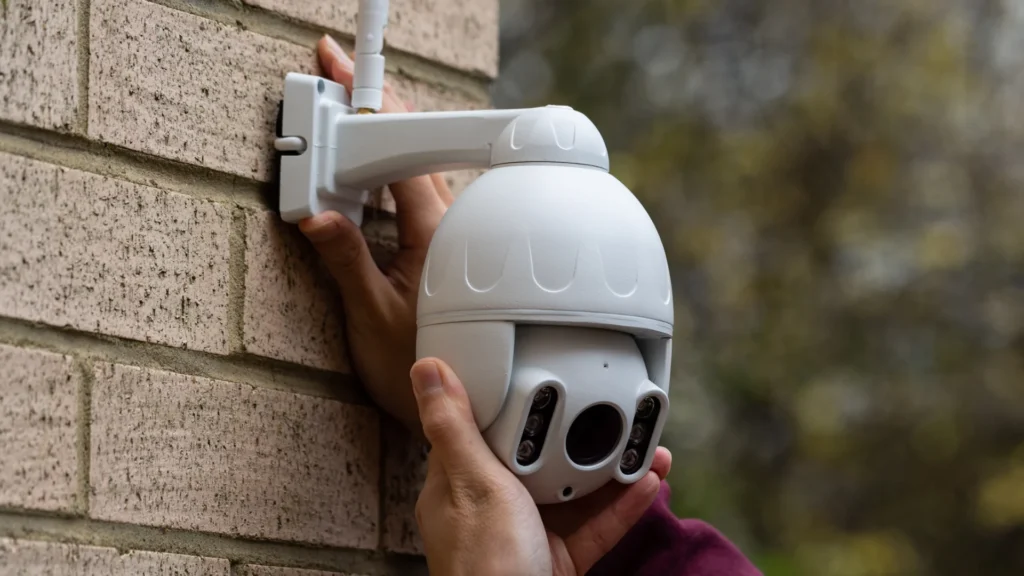
PTZ cameras, known for their pan, tilt, and zoom capabilities, offer unparalleled flexibility and coverage for monitoring expansive outdoor areas. These cameras are particularly effective when you need a thorough view of large spaces such as parking lots, stadiums, or industrial sites. The ability to pan horizontally, tilt vertically, and zoom in on specific areas makes PTZ cameras incredibly versatile.
The pan tilt function allows you to cover a wide range, eliminating the need for multiple static cameras. This versatility enables you to monitor different zones dynamically, adjusting the camera’s view as required. The zoom lens provides the ability to zero in on distant objects or activities, capturing high-detail footage that static cameras simply can’t achieve. This feature is indispensable for identifying faces, license plates, or any suspicious activity from afar.
Here’s a quick comparison to help you understand the key attributes of PTZ cameras:
| Feature | Benefit | Example Use Case |
|---|---|---|
| Pan Tilt | Wide coverage with fewer cameras | Monitoring large parking lots |
| Zoom Lens | Detailed close-ups from a distance | Identifying faces or license plates |
| Remote Control | Flexibility to adjust the view as needed | Security personnel adjusting in real-time |
| Preset Tours | Automated surveillance of multiple areas | Routine monitoring of industrial sites |
Choosing a PTZ camera for outdoor surveillance ensures you’re not limited by fixed viewpoints. You gain the freedom to monitor expansive areas dynamically and respond to unfolding events promptly. Whether you’re securing a commercial property or keeping an eye on a public space, the combination of pan tilt and zoom lens functionality in PTZ cameras provides a great blend of coverage and detail. This makes them a top choice for anyone seeking advanced surveillance capabilities without the restrictions of static cameras.
Thermal Cameras
When you’re looking to monitor areas with limited visibility or extreme conditions, thermal cameras offer unique advantages by detecting heat signatures rather than relying on visible light. This makes them an excellent choice for outdoor surveillance in various challenging environments.
Here’s why thermal cameras stand out:
- Thermal Imaging Technology: Thermal cameras use infrared sensors to create images based on heat emission. Unlike traditional cameras, they don’t depend on ambient light, allowing them to perform exceptionally well in complete darkness, fog, smoke, and even heavy rain. This technology guarantees you capture important details that other cameras might miss.
- Heat Detection Capabilities: One of the significant benefits of thermal cameras is their ability to detect minute differences in temperature. This is particularly useful for perimeter security, as these cameras can identify intruders or animals even if they’re camouflaged or hiding behind obstacles. The ability to detect heat signatures means you get real-time information about any potential threats.
- Enhanced Durability and Reliability: Outdoor environments can be harsh, with fluctuating temperatures and weather conditions. Thermal cameras are designed to withstand these extremes, offering robust performance where other types might fail. Their durability ensures long-term reliability, reducing maintenance and replacement costs.
When comparing thermal cameras to other outdoor surveillance options, their capacity to provide clear images regardless of lighting conditions is unmatched.
If your security needs involve monitoring vast perimeters, critical infrastructure, or high-risk areas, thermal imaging delivers unparalleled effectiveness. By focusing on heat detection, thermal cameras give you the freedom to secure your property with confidence, knowing that no detail goes unnoticed, no matter the time of day or weather conditions.
Wireless Cameras
Wireless cameras often provide a convenient and flexible solution for outdoor surveillance, eliminating the need for extensive cabling while still delivering high-quality video feeds. These cameras empower you with the freedom to install them virtually anywhere, making them ideal for covering vast outdoor spaces.
When considering wireless cameras, you should evaluate key features like battery power and signal range. Battery-powered cameras offer the advantage of easy installation without the need for a nearby power source, but keep in mind that you’ll need to monitor and recharge or replace batteries periodically. Signal range is another important factor; it determines how far you can place the camera from your Wi-Fi router without losing the connection. High-quality wireless cameras typically manage to balance these aspects well, ensuring reliable performance.
Here’s a comparison table to help you understand the trade-offs:
| Feature | Advantage | Consideration |
|---|---|---|
| Battery Powered | Easy to install anywhere | Regular battery maintenance needed |
| Signal Range | Greater flexibility in placement | Dependent on Wi-Fi strength |
| Video Quality | High-definition feeds available | Can be affected by signal strength |
In terms of product comparisons, brands like Arlo and Ring offer excellent battery-powered wireless cameras with robust signal ranges. Arlo’s Pro series, for example, provides long battery life and expansive signal coverage, making it suitable for larger properties. On the other hand, Ring’s Spotlight Cam offers integrated lighting and a siren, adding an extra layer of security.
Ultimately, if you value the freedom to position your cameras without worrying about power outlets and extensive cabling, wireless cameras are a top contender for your outdoor surveillance needs. Just be mindful of your Wi-Fi signal range and battery maintenance to ensure peak performance.
IP Cameras
When considering IP cameras for outdoor use, you’ll value their high-resolution image quality, which guarantees clear and detailed footage.
Additionally, their remote access capability allows you to monitor your property from anywhere, providing unmatched convenience and security.
Comparing models, you’ll find variations in resolution and connectivity features, helping you select the best fit for your needs.
High-Resolution Image Quality
High-resolution image quality in IP cameras guarantees you capture every detail with unparalleled clarity, making it essential for effective surveillance. With superior sensor quality, these cameras deliver crisp, clear images even in challenging lighting conditions.
When selecting an IP camera, pay close attention to the type of sensor it employs. High-resolution sensors, such as CMOS or CCD, make sure that the footage is sharp and detailed, helping you identify faces, license plates, and other critical elements effortlessly.
Equally important is the lens type. A high-quality lens can greatly enhance the camera’s resolution. Varifocal lenses are particularly advantageous as they allow you to adjust the focus and zoom, providing greater versatility in capturing wide or narrow fields of view. Fixed lenses, on the other hand, offer simplicity and reliability for specific surveillance needs.
To help you make an informed decision, consider the following:
- Sensor Quality: Opt for cameras with high-resolution CMOS or CCD sensors.
- Lens Type: Choose between varifocal for adjustable focus or fixed lenses for reliability.
- Image Processing: Make sure the camera has advanced image processing capabilities for excellent clarity.
Remote Access Capability
A critical feature of modern IP cameras is remote access capability, allowing you to view live footage and manage settings from virtually anywhere. This functionality is mainly achieved through mobile applications, which offer convenience and flexibility. You can monitor your property in real-time, receive instant alerts, and even control camera angles—all from your smartphone or tablet.
When evaluating the best IP cameras for outdoor use, consider those that offer robust mobile app support. Brands like Arlo, Ring, and Nest provide user-friendly apps that integrate seamlessly with their hardware, giving you a complete security solution. These apps often come with features like motion detection notifications and two-way audio, enhancing your ability to interact with your security system remotely.
Another significant advantage is cloud storage. Unlike traditional systems that rely on local storage, cloud storage ensures that your footage is safe and accessible even if the camera is tampered with or damaged. Companies like Canary and Wyze offer scalable storage plans, letting you adjust based on your needs.
This combination of remote access and cloud storage not only enhances security but also gives you the freedom to manage your system without being tied to a specific location.
Weather Resistance
Ensuring your outdoor CCTV camera can withstand extreme weather conditions is essential for uninterrupted surveillance and long-term durability. When selecting a CCTV camera, focusing on material durability and resistance to extreme temperatures can make a significant difference.
Here’s what you should consider:
- Material Durability: Look for cameras made from robust materials like stainless steel or aluminum. These metals not only provide strength but also resist corrosion, which is important for surviving outdoor elements. Plastic casings might be cheaper but are prone to cracking and degrading over time, especially in harsh weather.
- Extreme Temperatures: Your camera should operate efficiently in both scorching summers and freezing winters. Check the camera’s operating temperature range. High-quality models typically function well between -40°F and 140°F. This ensures that the camera won’t fail you when the weather hits its extremes, providing you with consistent surveillance year-round.
- Ingress Protection (IP) Rating: The IP rating indicates how well the camera is protected against dust and water. For outdoor cameras, an IP66 rating is the minimum you should accept. This guarantees that the camera is dust-tight and can handle powerful water jets, making it suitable for all weather conditions, including heavy rain and dust storms.
When comparing these models, you’ll notice that the range of IR illumination varies significantly. Model E, with a 120-foot range, offers the best performance, allowing you to monitor larger areas at night. This is ideal if you value extensive coverage and wish to maximize your security.
Low light performance is equally important. Cameras like Model A and Model E not only provide extensive IR range but also excel in low light conditions, ensuring clear and detailed footage. This is particularly beneficial in areas with minimal ambient light, where traditional cameras might struggle.
On the other hand, if your surveillance area is smaller or has some ambient lighting, models B, C, and D can still deliver satisfactory results. They offer good low light performance without the need for an extensive IR range.
Ultimately, your choice should balance IR range with low light performance based on your specific surveillance needs. Whether you prioritize wide coverage or exceptional clarity in near-total darkness, there’s a camera that fits your requirements.
Motion Detection
When assessing motion detection capabilities, you’ll want to explore how effectively the camera enhances security by distinguishing between real threats and harmless movements.
Advanced models often feature AI-driven algorithms that greatly reduce false alarms, ensuring you’re alerted only when it matters.
Comparing various products, you’ll notice some cameras offer customizable sensitivity settings, giving you greater control over your surveillance environment.
Enhanced Security Features
Among the myriad of enhanced security features in outdoor CCTV cameras, motion detection technology stands out as an essential element for real-time threat assessment and immediate response. When integrated with other advanced functionalities like facial recognition and audio recording, motion detection transforms your security system into a robust sentinel.
Here’s why motion detection is indispensable:
- Immediate Alerts:
Motion detection can instantly notify you of any suspicious activity, allowing you to take swift action. This is vital for preventing potential intrusions or vandalism.
- Storage Efficiency:
By activating recording only when movement is detected, you save considerable storage space. This means you don’t have to sift through hours of irrelevant footage.
- Integration with Other Features:
When paired with facial recognition, your camera can identify individuals and differentiate between known faces and potential threats. Combined with audio recording, you get a comprehensive security package that captures both visual and auditory evidence.
In your quest for freedom and peace of mind, opting for a motion detection-enabled CCTV camera offers a balanced blend of proactive monitoring and efficient resource management. Whether you’re safeguarding a residential property or a commercial space, this feature ensures you’re always a step ahead in security.
Reduced False Alarms
By leveraging advanced algorithms, motion detection technology in outdoor CCTV cameras greatly reduces false alarms, guaranteeing that you’re alerted only to genuine threats. The integration of AI allows these cameras to differentiate between trivial movements, like tree branches swaying, and potential intruders. This means you won’t be bogged down by unnecessary notifications.
When choosing an outdoor camera, it’s vital to compare the motion detection capabilities. Let’s look at how different models stack up:
| Feature | Basic Camera | Advanced AI Camera |
|---|---|---|
| False Alarm Rate | High | Very Low |
| Object Recognition | Limited | Sophisticated |
| Notification Filtering | Minimal | Highly Accurate |
| Environmental Adaptation | Poor | Excellent |
With AI integration, advanced CCTV cameras can adapt to various environments and conditions, further enhancing their accuracy. For instance, these cameras can analyze patterns over time, learning to ignore regular movements while focusing on unusual activities. This advanced technology ensures that your freedom isn’t compromised by constant false alarms.
Installation Tips
To guarantee peak performance and coverage, always mount your outdoor CCTV camera at a height that minimizes blind spots and maximizes field of view. Proper camera positioning is vital for capturing thorough footage while avoiding obstacles like tree branches or high-traffic areas that could skew the camera’s effectiveness. Ideally, place the camera 8 to 10 feet above the ground. This height discourages tampering and provides an ideal angle for facial recognition and license plate capture.
Cable management is another critical aspect of installation. Exposed wires aren’t only unsightly but can also be easily tampered with. Opt for weatherproof cables and conduits to protect against environmental elements. Consider using PoE (Power over Ethernet) options to reduce the number of cables needed, simplifying the installation process.
Here are three essential tips to ensure a seamless installation:
- Strategic Placement: Ensure your camera is pointed towards entry points like doors and windows. This maximizes the chances of capturing intruders and minimizes unnecessary recording of open spaces.
- Secure Wiring: Use cable clips or conduit to neatly bundle wires and keep them out of sight. For added security, run cables through walls or underground to thwart potential tampering.
- Testing and Adjusting: Once installed, rigorously test the camera’s field of view and adjust as necessary. Use the camera’s companion app or software to make sure it covers the intended areas without any blind spots.
Frequently Asked Questions
How Do I Choose the Right Storage Solution for My Outdoor CCTV Footage?
Choosing the right storage solution is a Herculean task. Prioritize storage capacity and consider cloud storage for its unlimited space and accessibility. Compare products based on cost, security features, and ease of access to suit your needs.
What Is the Average Lifespan of an Outdoor CCTV Camera?
You’ll typically find the average lifespan of an outdoor CCTV camera is 5-7 years. Guarantee weather resistance for durability. Proper installation tips include securing connections and mounting locations to maximize protection and longevity.
Are There Any Privacy Laws I Should Know About When Installing Outdoor Cctv?
‘Better safe than sorry’ applies here. Before installing outdoor CCTV, seek legal consultation to guarantee compliance with privacy laws. Also, obtaining neighbor consent can prevent future disputes. Knowing the regulations secures your freedom and peace of mind.
How Can I Prevent My Outdoor CCTV Camera From Being Hacked?
To safeguard your outdoor CCTV camera from being hacked, make sure you enable strong encryption protocols and regularly perform firmware updates. This guarantees that your system’s security measures are current, protecting your privacy and granting you peace of mind.
What Are the Maintenance Requirements for Outdoor CCTV Cameras?
Did you know 40% of CCTV failures stem from poor maintenance? Establish a regular cleaning schedule and make sure your camera has a weatherproof casing. This prevents damage from elements, guaranteeing reliable performance and longevity.
